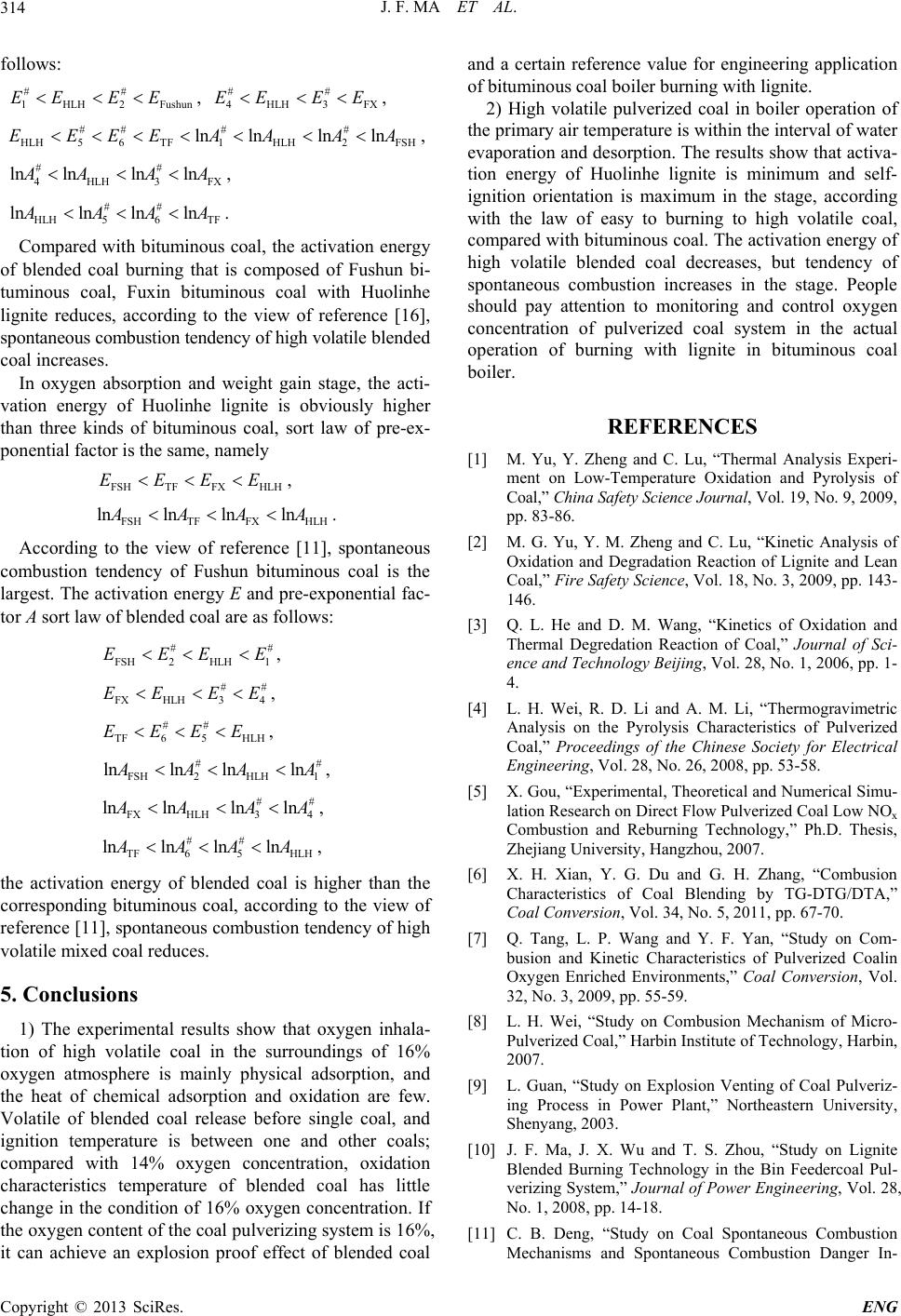
J. F. MA ET AL.
314
follows:
##
1HLH 2Fushun
EE EE , ,
##
4HLH3F
EE EE
X
FX
## ##
HLH 56TF1HLH2FSH
ln lnlnlnE EEEAAAA ,
##
4HLH3
ln lnlnln
AAA,
##
HLH 56TF
lnln ln ln
AAA .
Compared with bituminous coal, the activation energy
of blended coal burning that is composed of Fushun bi-
tuminous coal, Fuxin bituminous coal with Huolinhe
lignite reduces, according to the view of reference [16],
spontaneous combustion tendency of high volatile blended
coal increases.
In oxygen absorption and weight gain stage, the acti-
vation energy of Huolinhe lignite is obviously higher
than three kinds of bituminous coal, sort law of pre-ex-
ponential factor is the same, namely
FSHTF FXHLH
EEEE,
FSHTF FX HLH
lnln lnln
AAA .
According to the view of reference [11], spontaneous
combustion tendency of Fushun bituminous coal is the
largest. The activation energy E and pre-exponential fac-
tor A sort law of blended coal are as follows:
##
FSH2HLH 1
EEEE,
##
FX HLH 34
EE EE
,
##
TF 65HLH
EEEE ,
##
FSH2HLH 1
lnln lnln
AA A,
##
FX HLH 34
lnlnln ln
AAA
it can achieve an explosion proof effect of blended coal
eration of
th
REFERENCES
[1] M. Yu, Y. Zhlysis Experi-
Y. M. Zheng and C. Lu, “Kinetic Analysis of
He and D. M. Wang, “Kinetics of Oxidation and
H. Wei, R. D. Li and A. M. Li, “Thermogravimetric
al Simu-
ang, “Combusion
Com-
busion Mechanism of Micro-
n, “Study on Explosion Venting of Coal Pulveriz-
u and T. S. Zhou, “Study on Lignite
Coal Spontaneous Combustion
Mechanisms and Spontaneous Combustion Danger In-
,
##
TF 65HLH
lnln ln lnAAAA ,
the activation energy of blended coal is higher than the
corresponding bituminous coal, according to the view of
reference [11], spontaneous combustion tendency of high
volatile mixed coal reduces.
5. Conclusions
1) The experimental results show that oxygen inhala-
tion of high volatile coal in the surroundings of 16%
oxygen atmosphere is mainly physical adsorption, and
the heat of chemical adsorption and oxidation are few.
Volatile of blended coal release before single coal, and
ignition temperature is between one and other coals;
compared with 14% oxygen concentration, oxidation
characteristics temperature of blended coal has little
change in the condition of 16% oxygen concentration. If
the oxygen content of the coal pulverizing system is 16%,
and a certain reference value for engineering application
of bituminous coal boiler burning with lignite.
2) High volatile pulverized coal in boiler op
e primary air temperature is within the interval of water
evaporation and desorption. The results show that activa-
tion energy of Huolinhe lignite is minimum and self-
ignition orientation is maximum in the stage, according
with the law of easy to burning to high volatile coal,
compared with bituminous coal. The activation energy of
high volatile blended coal decreases, but tendency of
spontaneous combustion increases in the stage. People
should pay attention to monitoring and control oxygen
concentration of pulverized coal system in the actual
operation of burning with lignite in bituminous coal
boiler.
eng and C. Lu, “Thermal Ana
ment on Low-Temperature Oxidation and Pyrolysis of
Coal,” China Safety Science Journal, Vol. 19, No. 9, 2009,
pp. 83-86.
[2] M. G. Yu,
Oxidation and Degradation Reaction of Lignite and Lean
Coal,” Fire Safety Science, Vol. 18, No. 3, 2009, pp. 143-
146.
[3] Q. L.
Thermal Degredation Reaction of Coal,” Journal of Sci-
ence and Technology Beijing, Vol. 28, No. 1, 2006, pp. 1-
4.
[4] L.
Analysis on the Pyrolysis Characteristics of Pulverized
Coal,” Proceedings of the Chinese Society for Electrical
Engineering, Vol. 28, No. 26, 2008, pp. 53-58.
[5] X. Gou, “Experimental, Theoretical and Numeric
lation Research on Direct Flow Pulverized Coal Low NOx
Combustion and Reburning Technology,” Ph.D. Thesis,
Zhejiang University, Hangzhou, 2007.
[6] X. H. Xian, Y. G. Du and G. H. Zh
Characteristics of Coal Blending by TG-DTG/DTA,”
Coal Conversion, Vol. 34, No. 5, 2011, pp. 67-70.
[7] Q. Tang, L. P. Wang and Y. F. Yan, “Study on
busion and Kinetic Characteristics of Pulverized Coalin
Oxygen Enriched Environments,” Coal Conversion, Vol.
32, No. 3, 2009, pp. 55-59.
[8] L. H. Wei, “Study on Com
Pulverized Coal,” Harbin Institute of Technology, Harbin,
2007.
[9] L. Gua
ing Process in Power Plant,” Northeastern University,
Shenyang, 2003.
[10] J. F. Ma, J. X. W
Blended Burning Technology in the Bin Feedercoal Pul-
verizing System,” Journal of Power Engineering, Vol. 28,
No. 1, 2008, pp. 14-18.
[11] C. B. Deng, “Study on
Copyright © 2013 SciRes. ENG